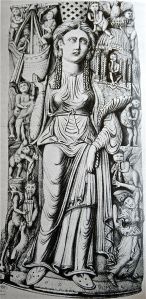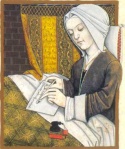
When the Christian Empire forcibly forbade the worship of the Pagan Deities, the Goddesses and Gods did not die. But They did go underground. Yet Isis was one of the ones Who retained Her presence among the western world perhaps more than any other.
One of the underground lairs of the Deities was euhemerism. It’s the idea that the old Pagan Deities are merely historical mortals who, because of their special talents or moral worth, eventually came to be worshiped as Goddesses and Gods as Their stories became exaggerated over time. The concept is named after Euhemerus, a 3rd century BCE Greek mythographer. It wasn’t his original concept, though, yet it is his name that became associated with it and here we are.
Euhemerism turned out to be not such a great look because ascending Christianity could use it to ridicule Pagans for being stupid in worshiping mere human beings. On the other hand, it preserved the stories of the Goddesses and Gods far into the West’s Christian-ruled centuries. You see, since these stories were not really about Deities, they could be told and retold without being a genuine threat to Christianity.
Churches and cathedrals of the Middle Ages were often decorated equally with images of Pagan Deities and Biblical characters. The sibyls of the Pagans and the prophets of the Bible were both considered people of wisdom from whom the churchgoer could learn. And while the Church wasn’t completely comfortable with this arrangement (and sometimes even railed against it) still the practice continued throughout the Middle Ages and into the Renaissance.
In these stories, Isis is often seen as a culture-bearer and philosopher. In 1508, John Trithemius, the Abbot of Spanheim, lists Isis among the “men” who devoted themselves to the study of wisdom.
Verily in these times, as it evidently appears from the Histories of the Ancients, men more earnestly applied themselves to the study of wisdom, amongst whom the last learned and most eminent men, were Mercurius, Bacchus, Omogyius, Isis, Ianachus, Argus, Apollo, Cecrops, and many more, who by their admirable inventions, both profited the world then, and posterity since.
John Trithemius, De Septem Secundeis, A0-6
Allegory was another refuge of the Pagan Deities. Allegory interprets the myths or attributes of the Pagan Deities as moral tales or philosophical concepts. Again, it was a method created by Pagans themselves to find additional meaning in their myths. The Neoplatonists of the late Pagan period used allegory as a method to refute the arguments of Christians who claimed moral superiority for their religion. Pagans could point to allegorical interpretations of the myths to show how Pagan myths taught honor, chastity, fidelity, and other virtues. Eventually, the myths of the Pagan Deities came to be used at least as often as Biblical stories to teach “Christian” values.
Today I’d like to introduce you to one of the writers who learned from the story of Isis and used it to teach moral virtues. Her name was Christine de Pisan (1364—1430 CE). De Pisan was born in Venice, but spent her life in France. Writing in the Late Middle Ages, de Pisan was an early feminist (some say the first feminist, some prefer proto-feminist); her work challenged misogyny and the gender stereotypes of her day. De Pisan was a fortunate medieval woman in that she had a lot of support from the men in her life. Her father, astrologer and secretary to King Charles V of France, taught her classical languages. She studied literature, mythology, history, and the Bible. She was married at 14 to Etienne du Castel, a nobleman from Picardy. He, too, supported his wife’s educational and writing endeavors.
When du Castel died of plague at age 25, Christine took to writing full time to support her three children and mother (who had not been as happy as her father with her work). She became the first woman writer to be able to support her family through her writing.
In much of her work, she wrote about the virtues of women as told in classical tales. She wrote poetry and prose, the biography of the King of France, she debated the anti-woman views in the Romance of the Rose as well as those coming from the pulpit, she wrote about the early victories of Joan of Arc when no one else had. Like Dante, she wrote about her visions; for instance, one in which Nature instructed her to write.

So where does Isis come into it? In two of her most famous works: the Epistle of Othea to Hector and the Book of the City of Women.
As the Goddess Othea, a Goddess she created to represent the “Wisdom of Women,” de Pisan writes to the young Trojan hero Hector, who represented the ideal knight. The Epistle consists of 100 stories meant to teach values to the young. All the stories are derived from Pagan texts and authors like Homer and Ovid. In Othea, de Pisan describes Isis (Ysys) as a planter and cultivator.
An illustration accompanying the text shows Isis grafting new branches on old trees. The knight is advised to follow the example of the Goddess and plant virtues in himself. The planting of these virtues is to be understood as similar to the conception of Jesus by the Blessed Virgin Mary, Whose “great bounties may be neither imagined nor said.” As was so frequently the case, here Isis is assimilated with Mary.
De Pisan’s Book of the City of Women starts with three Goddesses visiting Christine: Reason, Rectitude, and Justice. They tell her she must create a place where “ladies and valiant women may have a refuge and a defense against the various assailants.” Her book is that place, where she tells the tales of such valiant women in history, Isis among them, of course. In this entry, Isis is still the planting Goddess, but also the “a woman of such great learning acquired through labor that she was not only named the Queen of Egypt but also the most singular and special goddess of the Egyptians.”
She also conflates the story of Isis with Io and has Isis married to Apis rather than Serapis or Osiris, presumably wishing to keep any hint of the Isis and Osiris sibling marriage out of it. (For the story of Isis and Io, go here. ) De Pisan also tells us that Isis invented a shortform (hieratic or Coptic?) of writing, which helped the Egyptians manage “their excessively involved script.” (As I writer, this was important to her.) De Pisan also names Isis as a lawgiver and extremely just ruler, causing Her to be worshiped all through the world.
And so, while we cannot claim that the worship of our Lady Isis is an uninterrupted tradition, I think we can rightfully claim that Isis never left human awareness. From the time when Her worship was forbidden to modern times when so many have returned to be sheltered in Her loving wings, Ysis-Isis-Iset-Auset, as you wish, continued to live in myth, in allegory, in stories, in poems by first-feminist poets, in wisdom teachings, in alchemy, and in so many of the flowing streams of the Western Esoteric Tradition.
Isis is alive. The Goddess is alive. And yes, She always has been.








